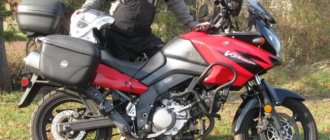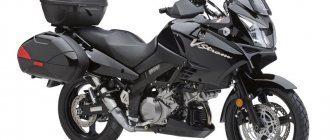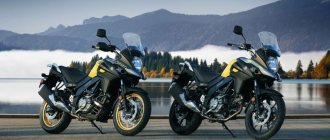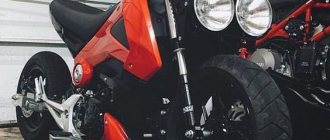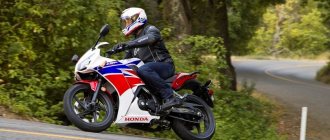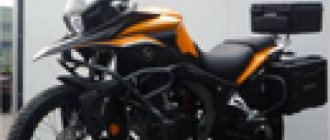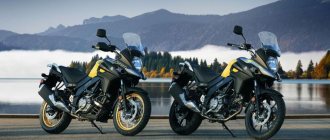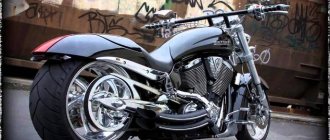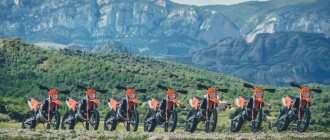The dual-purpose motorcycle Suzuki V Strom 1000 has been in production for more than a decade and a half, having undergone a number of significant modifications during this time, but without losing its popularity. It was loved by bikers for its equally good abilities both on and off the asphalt, and for its excellent suitability for long-distance motorcycle trips, including on low-quality roads. Powerful, reliable and unpretentious , this bike copes well with any tasks that the owner might like to assign to it.
Technical characteristics of Suzuki V Strom 1000
The Suzuki DL 1000 is too heavy to be called a full-fledged off-road “rogue”. His element is asphalt of any quality, dirt tracks and graders, which he copes with with a bang. Balanced technical characteristics make it a truly universal motorcycle.
Engine
Suzuki DL 1000 V Strom engine from the TL1000 sportbike. The high-torque V-shaped twin with liquid cooling produces 98 hp. and 104 Nm of torque ( 101 hp and 101 Nm for 2013+ models). Engine type 4 stroke, DOHC, with 4 valves per cylinder. The archaic engine has proven itself well for a long time, and, according to reviews, there are no problems with it. Owners only note a large number of vibrations, but they are practically not felt while driving, and therefore do not cause discomfort. But it accelerates the bike from 0 to 100 km/h in 3.6 seconds (from 2013 - in 3.02 seconds)!
Transmission
The standard 6-speed gearbox is reliable, but somewhat rough. Each gear change is constantly followed by a noticeable shock from somewhere in the depths of the transmission, creating the impression that the biker is riding not a Suzuki V Strom, but a Harley-Davidson. But this does not affect reliability in any way, and reliability is the main parameter for a touring motorcycle.
Chassis and brakes
Aluminum diagonal frame, light alloy wheels ( spoked ones ), solid weight, corresponding brakes - there is absolutely nothing to complain about. All copies since 2013 are equipped with an ABS system .
Long-travel suspensions cope well with uneven roads. Models produced in 2002 were equipped with a non-adjustable fork; from 2003, preload adjustment appeared, and from 2013, a full range of adjustments. The fully adjustable rear swingarm suspension with monoshock absorber has remained virtually unchanged since production began.
The front wheel has two 310 mm brake discs with 2-piston calipers (with 4-piston radials since 2013), and the rear wheel has 260 mm brake discs with a 1-piston caliper. It has enough brake efficiency, despite its considerable weight.
Electronics
Touring enduros place reliability at the forefront, and the simpler, as we know, the more reliable. Therefore, the electronic filling in the Suzuki V Strom is present, but moderate, and the design of the bike can hardly be called overcomplicated. If necessary, any electrician can easily figure it out, especially if he has a manual at hand.
Weight and dimensions
The dry weight of the bike is 207-208 kg , depending on the year of manufacture. The center of gravity is raised quite high, so subjectively it seems quite heavy. You have to tilt it very carefully, because it can quickly pass the point of no return and fall on its side.
Its dimensions are also impressive - 229.5 cm in length, width from 86.5 to 93 cm and height from 133.5 to 147 cm. The exact parameters depend on the generation. Ground clearance of 165 cm is enough for any roads.
Controllability
Despite such impressive dimensions, the Suzuki DL1000 V-Strom is controlled easily and naturally. Short motorcyclists may have some problems at near-zero speed - the seat height reaches 84-85 cm. But once you reach at least 15-20 km/h, the bike begins to steer almost by the power of thought. But at speeds above 150-160 km/h, it becomes too stable on course, and it’s not easy to force it to change direction.
Fuel consumption
It is about 6 liters per 100 km , if you maintain a cruising speed of around 120 km/h in top gear . In the city, consumption can increase to 7-8 liters. The fuel tank capacity is 22 liters for models produced before 2013, and 20 liters for all newer models. The cruising range in economy mode of the Suzuki DL1100 reaches 400 kilometers without refueling .
Test of two all-terrain motorcycles Suzuki V-Strom 650 and 1000 cc
Suzuki DL1000 V-Strom, 996 cm3, 98 l. s., 200 km/h Suzuki DL650 V-Strom, 645 cm3, 66.7 l. s., 175 km/h
It’s interesting to feel the difference between two outwardly almost identical, but internally different models. The trip route seemed to be the most optimal for testing their driving performance in various road conditions: on smooth metropolitan asphalt, but also on dirt roads, country roads, sand... A kind of imitation of a mini-trip as part of an on-site editorial session in nature. Indeed, why not? After all, these motorcycles are intended for long-distance driving.
In the Tver region, between Kashin and Kalyazin there is a bridge across the Volga. No matter how much I drive along it, I never cease to be amazed at the harmony of the lines of its forms above the majestic turn of the mighty river bed. And every time I want to return to it again and again. And if you really want something, then there will always be a reason. Like, for example, a test of two Suzuki all-terrain vehicles.
Of course, everything is not so banal. A comparison of these cars has been planned for a long time - it’s interesting to feel the difference between two outwardly almost identical, but internally different models. The trip route seemed to be the most optimal for testing their driving performance in various road conditions. After all, it is necessary to find out how cars behave not only on smooth asphalt in the capital, but also on dirt roads, country roads, sand... A kind of imitation of a mini-trip as part of an on-site editorial session in nature. Indeed, why not? After all, these motorcycles are intended for long-distance driving. Other factors also determined the choice. Thus, the Suzuki DL1000 V-Strom, which appeared two years ago, is still a “dark horse” in terms of consumer opinions, and its younger brother, the DL650, raises doubts about its professional suitability among many fans of “parquet” enduro. Why? Yes, we just haven’t seen a successful experience of installing a “weak” engine in a powerful chassis. Let me remind you that the chassis of the 650 and 1000 cm3 versions is identical, with minor exceptions. There are other twin traits. I’ll tell you more about them...
FIND FIVE DIFFERENCES
Having built a fairly stable table of ranks in the sector of large dual-purpose touring motorcycles, the “thousandth” V-Strom was given the role of leader among the “Japanese” in absentia. And all after numerous trips to Varadero. This Honda is too heavy! And if so, then, one wonders, why in this one, which is more appropriate to compare with Transalp and F650 GS? However, if you saw these two Suzukis side by side, you won't ask such questions. After all, the difference between the motorcycles is only the second muffler per “liter”, and $3050 in price tags. However, if you look around more carefully, there are more differences. The aluminum pendulum of the “liter” is clearly stiffer than the steel one of the “650”. There are also more hoods on the “liter” and – the height of chic – a dashboard finished “chrome”. Which dials look better - simple or shiny - is up to you to decide, but for me there are simply no external differences between the motorcycles. Just by color.
RAISING STANDARDS
It was not me who noticed that modern medium-sized engines are no longer “budget”, approaching “liters” in quality. So, the V-Strom 650, which is what I rode first, seemed quite responsive. Let me be clear: just the day before I rode the BMW R1200 GS, the test of which was published in the July Motor Review, and now in the saddle of the Susa I did not feel deprived! Acceleration to 100 km/h in less than five seconds will seem sluggish to asphalt extreme sports enthusiasts, but those who know the capabilities of motorcycles in the 650 cm3 class will be sincerely pleased.
It so happened that the escort minibus left before us, and we had to catch up with it through a huge traffic jam on the Moscow Ring Road. All this looks like TDM, I thought when I was drawing arcs between cars on the V-Strom. Yes, it was a motorcycle from Yamaha that opened this class of asphalt motorcycles with long-travel suspensions and, having set new standards 12 (!) years ago, has only now received worthy competitors. So, compared to the famous “stove”, Suzuki introduced slightly more inert handling with better comfort and driving stability. This is not to say that you want to turn and turn on it. But at the same time, Strom is very easy to drive! Only after BMW do you begin to appreciate Japanese motorcycles for their quality: get on and ride them quickly.
A torquey engine, a comfortable seating position for my height and precise ergonomics are three things that instantly make the ride enjoyable. Low footpegs will not please those who like to put the motorcycle deep into turns, but for my taste these exercises are not for enduro (albeit asphalt). Fortunately, traffic jams end sooner or later. So let's get started with high-speed maneuvering. The tachometer needle cheerfully moves towards the 10,000 rpm mark, the engine rustles joyfully (that’s how I would characterize its sound), and I’m already rushing at a speed of 160 km/h. "Hey, Africa Twin, where are you?" — the first thought that arose after quick acceleration. However, forgive me, fans of this wonderful motorcycle, which has been in production for the second decade. The V-Strom is unlikely to last that long...
Finally, Moscow remains behind us, and the expanses of the Yaroslavl Highway open before us, which on weekdays is not teeming with summer residents. I open the full throttle... After 160 km/h, the acceleration is no longer so brisk, making it clear that the engine is not a “liter” at all. But... 180, 190! Eat! These are the impressive numbers that the speedometer showed when the engine no longer wanted to accelerate the motorcycle. Very good, considering the fact that the actual speed is about 175 km/h. Alas, the movement after 160 km/h is no longer so stable - the front part is noticeably unloaded and the motorcycle begins to scour from side to side. But I’m on a test: I stop and hand over the motorcycle to the second driver, who weighs not 65 kg like me, but 90 kg. Everything fell into place and the wobbling stopped. It turned out that I should have eaten more as a child!
But, excuse me, what about the pendants? How did they react to the heavier driver? I answer - this unit on the V-Strom does not raise a single question, and the factory setting is ideal. We did not notice the slightest hint of sway or breakdown of the fork during heavy braking.
There are no complaints about the brakes of both motorcycles - they are adequate, the forces on the levers are in perfect order. Corresponds to the class of motorcycles.
ASPHALT OFF-ROAD
In the meantime, I got used to the V-Strom 1000. And, surprisingly, I experienced rather negative emotions at the first moment: The “650” engine is so good, so balanced that when you start to feel the sharp and rough power of the “liter”, it seems that comfort Still, it’s more important in this life. And only after assessing the longer gears and accelerating to 200 km/h, you realize that 98 hp. With. - not 67 l. With. Never before have I felt so little difference between motorcycles of different sizes. The suspension settings seem to be the same: only the greater mass at the front of the “liter” modification makes a difference in handling. Moreover, the difference is positive. Because the front is loaded, the motorcycle responds better to the steering wheel even at low speeds, but at high speeds this is invaluable. The V-Strom 1000 comes close to TDM in handling, revealing universal qualities to the consumer. Thus, on a grader, its energy-intensive suspensions allow you not to think about breakdowns. And the sportbike engine, which migrated to the motorcycle with the TL1000S, allows it to accelerate quickly even at speeds of under 200 km/h.
A smooth highway, straight for several kilometers, I start with a delay of a few seconds after 650. Maximum acceleration, I almost caught up with him, and the speedometer exceeded 200 km/h. And... oh, horror! I see in front of me a series of sections of asphalt “gnawed out” for repair with five-centimeter sharp edges. Everything happened so quickly that I didn’t even have time to get scared. A series of severe blows to the tires, wheels and suspension failed to knock the motorcycle off course. I didn’t fall, my nervous tension dropped sharply, I stopped. This is true. The front wheel is deformed. So much so that it is felt while driving (in a narrow range - at speeds of 90-110 km/h), but not so much that the tire goes flat. Looking ahead, I will say that the repair resulted in a wheel replacement ($470 per wheel and 2,400 rubles for labor while waiting three weeks for the part).
Of course, the incident did not help improve the mood, but we are going to the Volga! This means we are approaching the border of the Moscow region. Of course, the road immediately changes its character. There are more bumps and fewer cars. Both bikes ride confidently, and again the big V-Strom's better front end loading helps. His behavior is more stable and better predictable. At the same time, the driving comfort of both motorcycles is at a good level. The glass provides excellent protection from oncoming traffic, and vibrations do not exceed reasonable limits. More precisely: at 650 vibrations are simply not noticeable, but at the “liter” they appear only at 6500 rpm, disappearing almost immediately. And what are the mirrors like? Not only can you see everything you need in them, they also don’t vibrate.
TOURISTS
To evaluate one motorcycle you need to travel 20 km. To evaluate another, 500 is not enough. With the “Japanese” it is most often very simple - the mileage is 200 km, and everything about them is clear. With the V-Strom everything is different and I noticed some nuances only after driving 400 km. So, on the sandy beach I noticed that the “liter” not only handles well on the sand, but is also lightweight. Even in comparison with the Africa Twin (it’s better not to mention the Varadero here). The saddle height is a little low for my taste, but this is an advantage off-road - so when I had to turn around in a confined space, I did it with ease.
However, the long mileage also revealed that it would be nice to raise the saddles of both motorcycles a couple of centimeters - some fatigue was still felt after the road. Motorcycles can be safely recommended for tourism: a cruising speed of 150 km/h, strong luggage racks and decent wind protection - these are the components that will help on a long journey. The opportunity to move off the asphalt is also nice. Moreover, it was the “liter” that pleased me - making your way along the paths on it is no more difficult than on the “650”.
The final emphasis was placed on the final pass along the Moscow Ring Road - we were in a hurry, and therefore we were driving fast enough to assess whether the vehicles had enough power. I will say this: even the “650” modification allows a lot on the road. “Liter” is able to prove that, with certain skills, it will allow it to overtake sportsbikes with a similar engine. So the twins really turned out to have very similar characters, and, as often happens in such situations, the younger brother copies the older brother’s style and strives to be in no way inferior to him. Well, the eldest makes concessions, but if anything happens, he does not hesitate to demonstrate his strength.
Motorcycles are provided by the Bike Land motorcycle dealership, t.: (095) 596-81-00.
Suzuki DL1000 V-Strom + Balanced handling + Excellent wind protection + Acceptable off-road capabilities + Low weight - Increased vibration load - Insufficient dynamics at high speeds - A higher saddle = A real all-rounder
Suzuki DL650 V-Strom + Excellent engine performance + Excellent ergonomics + Looks like a liter - Lightens the front end at high speeds - Excessive "straightness" = Excellent price-performance-performance ratio
Test evaluation of Suzuki DL1000 V-Strom and Suzuki DL650 V-Strom
| Options |
Repair and tuning
V-Strom is inexpensive to maintain, and everything you need - spare parts, consumables, tuning - costs quite reasonable money. Thanks to its fairly simple design, you can service and repair it yourself in the garage, and there is enough tuning on Ebay and in foreign online stores.
Repair
This is a reliable and unpretentious bike that can withstand the longest journey in harsh conditions. Maintainability is also excellent, and tinkering around in the garage mostly comes down to regular maintenance. Breakdowns, of course, sometimes happen, but this model does not have any obvious weak points.
Spare parts
Dealers usually have nothing in stock except consumables, so Suzuki V Strom DL 1000 owners, like the vast majority of other Russian motorcyclists, have to order everything from abroad. On average, the cost of spare parts is comparable to that of any other Japanese bike in the mid-price segment.
Tuning
The most popular is the protection of liter V-Strom with sliders and cages, since when it falls on its side, plastic, which is not durable, often suffers. Motorcycle travelers improve their bikes in every way - higher windshields, luggage racks, panniers, charging ports for devices... There is enough tuning for this model, and for the most part it is aimed at improving the touring qualities of the motorcycle.
Motorcycle modifications
Usually there are two generations, although within each of them there are also a lot of minor changes. The first was produced from 2002 to 2012, and for several years was even sold in Europe under the name Kawasaki KLV1000. In 2013, a deep modernization of the model was carried out, which became noticeably prettier, acquired new V-twin engine settings, improved suspensions and a modern appearance. But both generations are well suited for the purpose for which they were created - to travel far, in comfort and in any conditions. The word “Strom” itself, translated from German, roughly means “powerful stream”, and this name fits the brutal touring enduro perfectly.
Test drive Suzuki V-Strom 650
The V-Strom650 first appeared on the market in 2004 - 2 years after the appearance of the older model. Step by step he earned himself popularity among buyers. And this did not require loud advertising campaigns. Its fame, as befits truly successful products, passed from mouth to mouth. An affordable price, good driving performance and a large share of versatility helped this motorcycle achieve a good level of sales and, in this indicator, significantly outperform the “liter”. The V-Strom650 had more than enough practicality. This helped him “stay afloat” for such a long time without significant improvements in the design. But 8 years is a serious period of time even for the most successful model. Time makes its own adjustments, and manufacturers are forced to modernize even their most successful motorcycles. But the question always arises: how to get by with “little loss” and change the model, improving it with a minimum of risk? As practice shows, Japanese manufacturers are very conservative and do not like to take risks. However, under the pressure of circumstances (read: competitors), they are capable of working miracles.
When Suzuki first announced the release of the new V-Strom650, many seriously decided that revolutionary changes awaited the motorcycle. After all, the previous model of this crossover is outdated, both in terms of design and morally. The V-Strom650 was no longer suitable as a truly universal touring motorcycle - two mid-sized BMW GS series were firmly entrenched in this niche. And last year, a competitor from the shores of Foggy Albion, the Triumph Tiger 800XC, burst into this field. To be at least on the same level with these two Europeans, the “Japanese”, like air, was shown a serious modernization.
But it turned out completely differently. Already from the first photographs thrown to warm up the public, it became clear that a miracle would not happen, and the new V-Strom650 would remain in the same niche of the touring enduro class (crossovers) in which it had been for the previous eight years. After the official presentation, the fears were confirmed. The essence of what happened can be described in the words of one American journalist: “They didn’t do anything wrong with the SuzukiV-Strom650. They didn’t do anything to him at all.” In fact, many changes have taken place in the motorcycle, but, by and large, the entire modernization ended with the installation of an improved power unit and a facelift of the appearance of the motorcycle. As a result, the V-StromDL650 of 2012, although it began to look more modern, functionally it cannot provide the buyer with anything new.
But what the Japanese who developed the motorcycle cannot be blamed for is practicality. After all, unlike the same universal F800GS and Tiger 800XC, most of whose buyers never leave the asphalt, any owner of the SuzukiV-Strom650 will be able to make the most of the potential of this motorcycle. And I was convinced of this by my own example, having tested one of the first official Ukrainian copies of the V-Strom650 model 2012.
Despite the updated design, the motorcycle is very similar in appearance to its predecessor. And only after a detailed examination the differences begin to emerge.
An updated instrument panel, an adjustable windshield, and improved driver's seat ergonomics are the first and visible set of updates. Warming up the engine and, at the same time, assessing the landing, I did not immediately realize that the seat had become higher. The press release lists its height as 835mm, which is 15mm higher than the previous model. Both the tank and the seat itself at the junction with it became narrower, which, on the contrary, gave the perception of the seat as lower. With this sensation, even I, with my height of 180 cm, stretched out my toes - I could not stand on a full foot with both legs. Realizing that this situation will not satisfy drivers whose height is below average, the designers also provided a low (optional, 815 mm) saddle. But while driving, the standard seat height no longer seemed high to me, since it allowed me to view the situation on the road over the roofs of most passenger cars.
In terms of handling, the motorcycle can be considered one of the friendliest. Excellent maneuverability at low speeds is complemented by good stability at high speeds. If you did not calculate the speed when entering a turn, the motorcycle can forgive you for such a mistake and easily round the trajectory. In most cases, you don’t even have to use countersteering to do this. The freedom it provides to change the trajectory already in the turn itself, even when moving with a strong inclination, is also striking.
Combined with a superbly functioning suspension, such handling makes the motorcycle an excellent all-rounder for Ukrainian roads - from daily use to long trips. Even if there is clumsy asphalt under the wheels, the suspensions work out the unevenness perfectly, giving the motorcycle the opportunity to accurately follow the intended course. The almost “off-road” diameter of the 19-inch front wheel contributes largely to the smoothness of the ride. Trying to find the limit of comfortable overcoming potholes on Kyiv roads, I more than once deliberately drove into asphalt chips that I would have avoided on any other road motorcycle. And, to my admiration, the motorcycle never wavered, but swallowed all the bumps with enviable indifference. I am sure that it will not fail even when driving together, because both the front and rear suspension are adjusted by spring preload, and the rear suspension, in addition, by rebound damping.
The bass sound of the exhaust, which can intimidate drivers of neighboring cars and also indicate your place on the road, also adds a pleasant impression. The rate of increase in engine speed when opening the gas does not lag behind the “musical accompaniment”. In first, second and even third gear, the motorcycle is able to accelerate sharply in order to squeeze through the resulting window in traffic or overtake. Engine displacement remains unchanged, but thanks to many internal improvements, power and torque are up slightly throughout the rev range. The solid torque of the updated engine is felt already at 3000 rpm. To actively move, you don’t need to push the arrow into the red zone at all. It is quite enough to keep it within 3-5 thousand rpm and not open the gas more than halfway. This type of engine operation was never even dreamed of by “in-line fours” of similar cubic capacity. And this “twin” can handle it. But the V-twin has another feature - a jerky ride at very low or idle speeds, for example, in stretches. I have already encountered similar behavior of motorcycles with this type of engine more than once, and therefore I was pleasantly surprised when the V-Strom demonstrated calm and jerk-free movement at idle. In first gear, you can move at a speed of 8-10 km/h without pressing the clutch lever, in second gear - 12-15 km/h, and when you open the gas, you just gradually pick up speed. The reason for this behavior may lie in the proprietary Suzuki Dual Throttle Valve system used on this V-Strom model with two throttle valves per cylinder, one of which is controlled electronically.
The motorcycle is quite large, and therefore maneuvering in traffic jams can initially cause a feeling of discomfort. So it was with me. But exactly until I turned the steering wheel to the limit. It felt like it was more than 45 degrees away from the bike's axis, far more than any other bike I've ever ridden. With such a turn, you can get out of even the most dense traffic jam or turn around within one lane. The height of the steering wheel turned out to be very successful, the handles of which are located just above the level of the passenger car mirrors, which allows you to move between their crowded rows without fear.
The complaints about the visibility of the mirrors that arose at the beginning of the test very quickly disappeared. Their shape, of course, does not imply super visibility (which only a rear view camera can provide), but with careful adjustment they can minimize even the usual head turns when checking blind spots. Vibrations are not transmitted to them either - the picture is always clear.
I was also pleased with the excellent performance of the V-Strom gearbox and clutch. Gears always shift quickly and clearly, and neutral is found on the first try. I already thought that the engineers had “licked” this unit from Honda, if not for the loud “clack” on the first one, which they obviously overheard from Kawasaki. In the city, the first three gears are most in demand, although sometimes the numbers “4” or even “5” may appear on the dashboard display - there is enough engine thrust. But the sixth gear of this motorcycle is more like an overdrive mode. It should only be turned on outside the city to save fuel.
And, since we are already talking about savings, it is worth noting that the new engine promises to be somewhat more economical than the previous one. However, exactly how much is not known. But with a 2-liter smaller fuel tank volume, the manufacturer promises a power reserve similar to its predecessor. In fact, in urban driving mode, the average fuel consumption, displayed, like the gear engaged, on the dashboard, ranged from 4.5 liters per hundred when driving alone, and up to 6.5 liters when driving with a passenger and luggage. In total, according to the test results, consumption was 5.5 liters per 100 km (according to the computer).
Engineers may have worked to improve wind protection. In fact, this manifests itself in a reshaped front fairing and a new height-adjustable windshield. Given my height, the wind protection seemed quite acceptable to me even with the standard middle position of the windshield, but I had some complaints about the way it was adjusted. In order to change its height, you need to unscrew 4 screws, rearrange the plugs and only then fix the glass higher or lower. The glass was adjusted in a similar way on its predecessor.
If earlier buyers of the V-Strom650 had a choice - to buy a motorcycle with or without ABS, then starting with this model, such a question no longer arises. The motorcycle is equipped with ABS by default and the version without it is simply not produced. As for the quality of operation of this system on the V-Strom650, it is quite acceptable. Although the kickback on the brake lever sometimes seems excessive. I never managed to lock the wheels on the asphalt, but during sharp braking on the dirt road there was a moment when both wheels skidded for a moment. The electronics immediately “caught” them and further braking proceeded in a completely controlled manner, right up to the stop. Although the bike has shed almost 6 kg of weight, it is not lightweight. In addition, its center of gravity is quite high. And, although standard tires suggest the possibility of driving on dirt roads, this activity without additional “sharpening” of the motorcycle for off-road use does not evoke much enthusiasm. It feels like this is not his element.
Despite numerous updates, the 650 V-Strom remains just as good a motorcycle as its predecessor. It hasn't become any more endurable or competitive in this regard, but it won't scare away beginners either. It’s hard to imagine what Suzuki’s marketers were hoping for when they launched this model on the market – obviously not a sharp surge in its sales. To reach such heights, more than a redesign is clearly needed. Most likely, their goal was not a surge, but rather maintaining the high level of these sales achieved. Therefore, the SuzukiV-Strom650 2012 model year cannot be considered a competitor to the BMW 800GS and Tiger 800XC. It does not have the obvious zest inherent in a Bavarian or the charisma of a Briton, nor does it have broad on-road and off-road versatility. But, at the same time, it is more than self-sufficient and, within the confines of a road with any surface, is capable of much. And this is almost everything you could want from a motorcycle “for every day and more.”
Opinion: Valery Chuikov
Height: 186 cm, weight: 120 kg.
I was the owner of two “liter” V-Stroms - they were faster and ergonomically suited me better, but I only managed to drive their “younger brother” for a week in the States in 2008. Despite the frankly weak wind protection for my height and the absolute impossibility of adjusting the position of the windshield so that turbulent flows do not reach me, on the whole I liked that motorcycle. It consumed little fuel (on average 5l/100km), easily digesting the American “regular”, an analogue of our “92”, and was unpretentious to the condition of the road surface. And it was inexpensive.
And now, below me is a restyled model, so after taking a ride, you can play the game “Find 10 (or at least 5) differences.”
Appearance. Honestly, I was disappointed. Why did the designers need to remove the will, determination and adventurism from the appearance of the new V-Strom and add these amorphous, smooth lines, dividing zones into color fields and thereby bringing the appearance of the “universal soldier” closer to such an asexual creature as Gladius? Moreover, giving the headlights a completely unmasculine, touchingly pleading expression. Did you want to emphasize his humility and make him attractive to the “weaker sex”? Maybe. But from my point of view, this is “no good”.
Landing. There is a clear feeling that the motorcycle has become lower, but according to the numbers, on the contrary, the seat height has increased! The trick is that it has become narrower in the place where the hips touch it, hence the sensation. The modified tank makes it possible to better feel the movement of the motorcycle, hence, perhaps, the impression of improved handling, which, we must pay tribute to the designers, is excellent! But the wind protection didn’t get any better – at least for me. The glass is still located far and low, and its dimensions are insufficient to 100% fulfill its function.
Engine and gearbox. The engine has clearly been given some “low end” and improved power delivery throughout the entire rev range. Everything would have been just fine, if not for one “BUT”: the gorgeous impression was ruined for me by the fuzzy operation of the throttle. Unfortunately, there was no time to find out the exact cause of the unnecessary play and resulting delayed engine response, but it seems to be poor throttle actuator adjustment. I hope this can be fixed by the service. The gearbox works so well that I want to get up, step aside and see if the motorcycle under me has been changed!
Controllability. For a crossover (or SUV, depending on your preference) it is simply amazing! This seems incredible, but a motorcycle with considerable suspension travel (by the standards of “sports” as a standard) steers so clearly that at first you fall into a stupor and want to understand what the catch is. Maybe the suspension is tight? Or has the fork angle changed? But the next paragraph breaks this assumption.
Pendants. They worked quite well on the predecessor, but here the manufacturer managed to do the incredible and the motorcycle, with the same settings, rides perfectly on both smooth and rough asphalt, unnoticed by speed bumps and on the dirt road! Perhaps if you try to put the new V-Strom into the corners of the track, they will give up, but why mock the technology?!
In general, the new model “kept the bar” and in some ways even improved the performance of its predecessor. If the price were a little lower - and perhaps a queue of buyers could become a reality even in our difficult times!
Thank you for providing the V-Strom 650 ABS motorcycle for testing to DP Auto International, the official distributor of Suzuki motorcycles in Ukraine.
Text: Vladislav Sofonov
Photo: Andrey Shlenchak
Advantages and disadvantages
Suzuki V-Strom has enough positive and negative qualities. It was even nicknamed the “ poor man’s goose ,” hinting that it competes in the same class as the famous BMW R1200GS, inferior to it in almost all respects. But it costs much less, which is a decisive factor for many bikers.
Advantages
- Excellent low end traction . A slight turn of the throttle is enough, and the Suzuki V Strom 1000 quickly takes off, with a solid growl from the engine.
- Simple design . There is a minimum of any optional electronics in this model, and the chances of getting stuck in the middle of the steppe due to some failed tricky sensor tend to be minimal.
- Versatility . The bike feels confident in city traffic, it has enough power for any overtaking, and in terms of acceleration dynamics it is not much inferior to sportbikes. At the same time, it is great for long trips, especially if you equip it with panniers and other attachments.
Flaws
- Relatively fragile plastic . If dropped, it may break, especially if you drop the motorcycle not on soft ground, but on asphalt.
- Vibrations . They exist, there are many of them, and even though they do not cause serious inconvenience, some owners still complain about them.
- High center of gravity . Because of this, those motorcyclists who cannot confidently touch the ground with their feet may find it difficult to control the Suzuki V-Strom in traffic jams.
I picked up my Suzuki V-Strom 1000 in another city, while driving home, I almost immediately realized that this was exactly what I had been looking for for a long time. Controllability, comfort, decent average speed without straining or violence to the engine, wind protection, sound - everything is excellent. The seating position is such that your back doesn’t hurt afterwards, and the steering wheel is comfortable, your hands don’t get tired of it. It’s easy to change lanes even at speed, the bike obediently maneuvers at 60 km/h or 160 km/h. In short, I’m still delighted, although I’ve been riding it for several seasons now.
I didn’t like riding my old bike at night, much less in a car. Having bought this bike, night trips now seem like paradise to me - the light is powerful, and the suspension allows me not to be afraid of protruding sewer hatches and all kinds of holes, except for those in which a jeep can accidentally leave a wheel. You can pass speed bumps without slowing down.
In one weekend I somehow covered almost eight hundred kilometers and didn’t even get tired. From this I conclude that it is possible and even necessary to travel long distances on it, although I did not go far, I took the V-Strom 1000 because of its chassis, engine and appearance. Fuel consumption is low, although it is higher than that of the 650, and the gas tank capacity is substantial. The wind protection, as I already said, seems to be at the level, you can calmly sit straight at any speed and not worry - it doesn’t blow away.
It also became clear in practice that although it is possible to drive through large muddy areas and along village roads, it is very difficult due to the weight and height. Without the panniers and the rider itself, the bike weighs 230 kilograms, that is, it is a dry mass, and the center of gravity is high, and I can hardly reach the ground with both feet. As you understand, it will not be easy to pull such a colossus out of the mud if it gets stuck, although it is quite possible to lift a motorcycle that has fallen on its side, I had a chance to test it for myself.
As for the height of the motorcyclist, I will say that I personally am 176 centimeters, and I feel normal, but I don’t reach the ground with my feet as confidently as I would like. The bike is unlikely to be suitable for people shorter than me; it will be simply inconvenient and dangerous, and you might fall over. Beginners can try the bike as their first motorcycle, but if I were them, I would look at the Strom 650, it differs from the liter only in the engine. I think this will be a good experience for them.
Similar articles:
- Reviews from Honda XL 1000V Varadero owners
- Suzuki SV 650 owner review
- Yamaha XJR 1200 owner review
- Suzuki DR 800 owner review
- Review from owner of Suzuki GSF 1250 Bandit
- Review of Suzuki DL 1000 V-Strom
LiveJournal
Owner reviews
Mot a fairy tale! I actually bought it by accident, I was going to buy Varadera, but when I came to look, I realized that I couldn’t handle this behemoth. There was also a 650 cc Strom, I liked it much better, so I ended up looking for a liter one, which I bought. It's been on it for four years now, 40+ thousand kilometers have been covered without any breakdowns. Japanese quality! Arthur, Novorossiysk.
An indistinct motorcycle for who knows what. It doesn’t handle a tourenduro, it drives normally on the ground only on bad tires, which on the asphalt die to zero after 5,000 km and tries to fall over due to the weight. There are lows, but no highs at all. I didn’t like it, skated the season and sold it, bought Cava Versus - heaven and earth, Cava is a rocket compared to Strom. Sergey, Novosibirsk.
I became interested in the model when I came across a review of the V Storm 1000 on YouTube. The price tag is humane, the performance characteristics are not bad, I didn’t think twice about it - I bought it. The motorcycle came to the rescue more than once; I rode on it along Romanian serpentines at near-zero temperatures, and got caught in a storm on the Spanish coast, and reached Morocco that year via Gibraltar. The mileage has already exceeded 100 thousand, of which almost 80 are mine, no problems. I changed the sprockets and chain, naturally, the clutch, rebuilt the fork three times, the rear caliper was leaking - the repair kit came to the rescue. Pavel, Moscow.
Conclusion
The Suzuki V Strom 1000 impresses because it offers a lot for a low price. It is quite archaic in its design, but it has what touring bikes are valued for - high reliability, long range, comfort and a solid power reserve . It is inferior to more technically advanced competitors from BMW and KTM, but for its price it will always find its buyer.
Specifications
| Maximum engine power: | 98.0 hp (72.0 kW) at 7500 rpm - DL1000 (2002-2012). 101.0 hp (74.0 kW) at 8500 rpm – DL1000 (2013+) HP |
| Torque: | 104.0 Nm (10.5 kg*m) at 6500 rpm - DL1000 (2002-2012). 101.0 Nm (10.2 kg*m) at 4000 rpm – DL1000 (2013+) Nm |
| Working volume: | 996 cm³ – DL1000 (2002-2012). 1037 cm³ – DL1000 (2013+) cm3 |
| Motor type (cylinder arrangement, number of strokes): | 2-cylinder, 4-stroke, V-shaped (L-shaped) |
| Number of cylinders: | 2 |
| Number of valves: | |
| Intake type (Injector / Carburetor): | |
| Bore and stroke: | |
| Starting system (Electric starter, kick starter): | |
| Maximum speed in km/h: | 199 km/h – DL1000 (2002-2012). 214 km/h – DL1000 (2013+) km/h |
| Cooling system: | Liquid cooling |
| Transmission (gearbox): | 6-speed |
| Clutch (Dry / Wet): | |
| Drive unit: | Chain |
| Frame: | Aluminum diagonal |
| Chassis | |
| Suspension (front/rear travel): | |
| Brakes (Front/Rear): | |
| Wheels / Tires / Rubber: | |
| Dimensions and weight | |
| Dimensions (Length / Width): | |
| Seat height: | |
| Ground clearance: | |
| Curb weight: | |
| Wheelbase: | 1535 mm – DL1000 (2002-2012). 1555 mm – DL1000 (2013+) mm |
| Weight: | 207 kg – DL1000 (2002-2003), DL1000 XT. 208 kg – DL1000 (2004+) kg |
| Fuel tank capacity: | 22.0 l – DL1000 (2002-2012). 20.0 l – DL1000 (2013+) l. |
| Battery capacity: | |
| Year of release: | |
| Country of Origin: |
Test drive SuzukiDL 1000 V-Strom
Do you want to travel? Yes, to go far, together, quickly and comfortably, with luggage, and without particularly worrying about the quality of the road surface... Do you think that only Ukrainian motorcyclists, forced to peer into every bump on the asphalt, can think this way? No, oddly enough, Europe and America also have a lot of very interesting places with not very good (and even very bad) roads. To satisfy such sophisticated needs of motorcycle travelers, manufacturers at one time came up with a new class of motorcycles with advanced capabilities, almost like those of an enduro, but with the speed and comfort of “tourists.” Its top segment is, of course, “liters”. We were able to “touch” and compare the two most common of them.
This rarely happens, but they turned out to be as close as possible in everything. The technical data sheets of both motorcycles had the same year of manufacture, they were identically equipped (three branded luggage cases, alarms, crash bars, optional windshields). The rivals' odometers showed similar mileage figures: Suzuki's was 11,224 km, Honda's was 10,620 km. Both lack ABS (on the “liter” V-strom it is not even included in the options). Even the tires were the same model, Bridgestone Trail Wing 101/152! Thus, the starting conditions of the test for the opponents can be considered ideal.
The “elder” in this pair is the Honda XL1000V Varadero, which began its journey almost 10 years ago, in 1999. He is the founder of this segment, but the Suzuki DLl000 V-Strom became a reasonable “retaliatory strike from a competitor,” and a very successful one, although somewhat belated (the first production copies appeared in 2002). Three years of Varadero's undivided reign in this segment played into the hands of the model, and given that the market was “warmed up”, its popularity reached significant heights. But competitors from Suzuki were also not asleep, pitting their fuel-injected “horse” against their carburetor rival. It took Honda 1.5 years to launch a “counterattack” and radically update its model.
In general, when you compare the technical characteristics of these motorcycles, you are amazed at how similar they are (for example, the displacement and dimensions of the engines are the same). But this is not at all because Suzuki engineers successfully “licked” all the drawings in the rival’s camp; that would not be like a samurai. It’s just that the units around which these slender “runners” for long distances with obstacles were created were V-shaped engines from sportbikes (VTR1000F Firestorm and TL1000S, respectively), so both Honda and Suzuki had time to spy on each other even earlier .
When releasing the V-Strom into the world, Suzuki engineers thoroughly reworked the base engine. It received new pistons, a special anti-friction coating was applied to the surface of the cylinders, and the ignition and timing systems were completely redesigned. But MOST IMPORTANTLY, this engine was equipped with a modern fuel injection system with double valves (exactly the same as on the GSX-R1000 sports bike). Thanks to it, the V-Strom engine has excellent feedback and accurate torque dosing, which, by the way, has become “juicier” at medium speeds.
Until the 2004 model year, the Varadero was powered by carburetors and had a different transmission and suspension. After the first modernization in 2002, the motorcycle acquired a proprietary HISS immobilizer and modified rear suspension settings. The sample being tested is from the next generation Varadero, which was restyled at the end of 2003. Then the carburetors were replaced with a proprietary PGM-FI injection system and ABS was added (as an option). But this is all theory. What do we have in practice?
Let's start with landing. Despite the fact that the Varadero is slightly higher in the saddle, I personally find it more comfortable to sit on the V-strom. Firstly, the handlebar-pegs-saddle triangle itself seems to be designed for my height, and secondly, the profile of the seat cushion on a Honda noticeably narrows towards the tank and therefore I want to sit further away, on its widest part. But then you have to reach for the steering wheel, and this is annoying. Suzuki provides a more relaxed riding position. But the Varadero has a taller windshield with better wind protection (both manufacturers introduced height adjustment later). Both motorcycles “in stock” sport plastic “burdocks” that protect hands from insects and wind, are also equipped with central steps and carry three original luggage cases (both the first and second are options).
The tanks differ in capacity (the Honda has 3 liters more), according to the appetites of the subjects, while it is more convenient to squeeze the more profiled tank on the Honda with your knees. Starting the engine on both motorcycles requires squeezing the clutch lever - a kind of foolproof protection. Since the engines are injection, the intensity of their operation during warming up is adjusted automatically and there are no shifters covering the dampers. The sound of the engines is very similar (which is not surprising), but the Suzuki has a deeper and richer sound, while the Honda sounds a little dry. Oddly enough, starting is easier on the heavier Varadero, although the clutch lever is tighter. The dynamics of its acceleration are almost smooth, with a noticeable pick-up in the middle of the crankshaft speed range and the guttural roar of the V-twin that dispersed after the engine. The V-strom, when starting, requires a boost of gas and accelerates weakly and uncertainly up to 3 thousand rpm, but having overcome this mark, its engine “wakes up” and then “spun” so aggressively that the tachometer needle literally jumps over the entire scale. The sportbike roots are more pronounced in it. It’s as if he’s saying: “Hey, you! Didn't you fall asleep there for an hour? Why are we trailing behind this “tin can”? Step on the gas and “do” it! Turn up the speed, let everyone hear my roar!”
Both in feel and in measurements, the V-strom accelerates clearly faster than the Varadero and generally behaves provocatively, constantly pushing it to be driven more aggressively. At the same time, his voice actually sounds louder, attracting the attention of drivers and unwary pedestrians from afar. To its credit, it reinforces this requirement for aggressive driving with excellent handling and fast cornering (as they say, “playfully”). You can say: “easy to lie down, easy to get up,” so it’s a pleasure to overcome some overly winding section of the road on it, for example, a mountain serpentine.
But turning the XL1000V in sharp turns is already a job, the implementation of which is a necessity and nothing more. The reason for this is greater weight than that of its competitor and its slightly different distribution along the axes, plus a more “stretched” throttle handle, which worsens feedback in the driver-motor-wheel chain. All this together implies less aggressive (read: smoother) cornering, but contributes to the safety of this process, especially if the route is a “first ascent”. But the gearbox works quietly, clearly and, I would say, comfortably. You get used to this way of working so quickly that when you switch to the DL1000, at first you experience slight irritation from the “sweeping” of its foot, the less clear inclusion of “neutral” and the clattering sound with each switch (especially strong when turning on “first”). But the clarity of switching is generally acceptable, so you quickly forget about these relative inconveniences, carried away by the dynamics and blood-stirring sound of the engine.
To illustrate the difference in the characters of such similar motorcycles, I would like to cite the results of one observation, which were somewhat unexpected for me. While riding any motorcycle, an experienced pilot can always find (and does find) the so-called “state of dynamic balance”, which is purely individual for different devices, when the noise of the engine, its speed, the operation of the suspension and the speed constant give him a feeling of self-confidence and motorcycle, as well as comfort and peace (in the sense of not worrying about anything), when there is no irritation from the wind noise or the sound of the engine and everything is under control. I think everyone who has ridden enough on various types and models of motorcycles will understand me. So, with relatively free traffic, this state occurs on Varadero in the range of 100-125 km/h, and on V-strom - 125-150 km/h
Of course, the Suzuki V-strom is more sporty (and provocative) in nature and therefore requires a cool head and skillful pilot input, providing in return a deeper and more thrilling experience. The quieter, but no less dynamic Honda Varadero behaves, one might say, more solidly, without causing the desire to either lift the front wheel into the air or test the maximum lean angle in a turn. But since the characters of such similar “stayers” are so different, a reasonable question arises: how do motorcycles behave when braking? Honda has a “trump card” in its pocket - its proprietary system of so-called “double braking”, when when one of the circuits (front or rear) is activated, part of the pistons in the other is activated adequately, providing such a dosed distribution of braking force between the front and rear wheels, which under extreme braking it is rarely accessible even to a very experienced rider. You can brake on Varadero carefree and this is pleasant - the likelihood of wheel locking is significantly reduced even without the ABS system. In addition, this distribution slightly eliminates the possible disadvantages of certain tires associated with their grip properties, which is especially important when different tire models are installed on the front and rear wheels. Beginners should like these circumstances. What about the V-strom “athlete”? It would seem that it can only compensate for the lack of a “smart” braking system with a larger diameter of brake discs and lighter weight. But this is not entirely true, since it has a little better information content of the braking system, although, of course, in order to be able to use its capabilities as efficiently as possible, you need to have experience. For beginners this may be a minus, but for experienced pilots it is rather a plus. Well, as they say, “for a snack” let’s take a closer look at the off-road capabilities of the competitors. To be honest, the phrase “off-road capabilities” for these motorcycles is a relative concept, since they are not suitable for long-term riding on serious off-road conditions, but they can drive on hard ground to a lake or river, just like on a “gravel road” or to the end of a broken road. asphalt. In this discipline, Suzuki is inferior to Honda in terms of ground clearance, but wins in terms of suspension travel. In practice, this is expressed in the fact that Varadero has more chances to quickly move along gentle, wave-like uneven surfaces without catching them with its “belly,” but the “Storm” has a better chance of jumping over potholes and potholes. In urban use, Honda is better able to “assault” sidewalk edges; here the ground clearance plays a major role. But the opportunity to improve this parameter on Suzuki exists. It is enough to purchase a special kit for the rear suspension (costing about 80 euros), install it and the V-strom will “grow” by as much as three centimeters. This “tuning” is not suitable for those who buy a Suzuki precisely because it is lower on the saddle and will appeal to everyone who does not like to scrape the center stand over curbs and other uneven surfaces. And finally – about comfort. Here, in almost all respects (except for slightly worse wind protection), V-strom is the leader. Its suspensions perfectly “swallow” most road irregularities, without particularly disturbing the driver’s “butt” with hand impacts. But the Varadero was upset by the harsh passage of almost all types of asphalt “troubles” common to Ukrainian roads, accompanied by unpleasant shocks from both suspensions. This is all the more strange, because its carburetor predecessor was more loyal to its riders.
What do we have, so to speak, “in the bottom line”? Those who like to have a universal motorcycle with a “spice” in character and who prefer high-speed asphalt rides to trips “out into nature” will definitely like the Suzuki DL1000 V-strom. For those who love long journeys along difficult routes and prefer stability and predictable behavior of their motorcycle, the Honda XL1000V Varadero should be suitable. Yes, I almost forgot, you should also take into account the price difference, and it is in favor of V-strom.
Text: Valera DRIVE
Photo: Andrey Shlenchak
